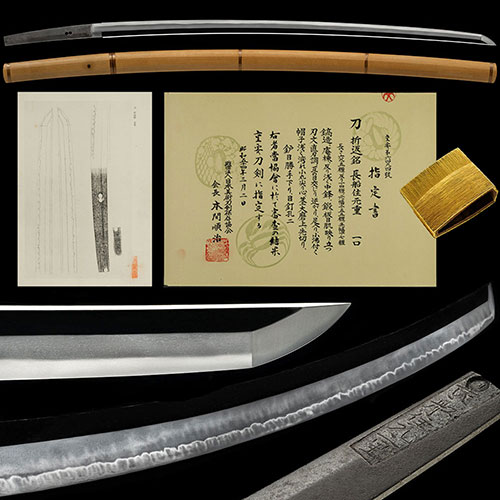
元重 刀 Motoshige Katana
No.280774折返銘 長船住元重 乱れ映り鮮やかに立つ精良な地鉄に片落ち互の目逆足頻りに入り金筋掛る傑作 二尺二寸九分Orikaeshi-Mei, Osafune jyu Motoshige, Midare-Utsuri vividly with good clear Jigane, Kataochi-Gunome, Sakaashi entered frequently, Kinsuji-kakaru, A masterpiece 69.5cm
- 登録証Registration
- 東京都 Tokyo 令和2年7月18日 7/18/2(Reiwa)
- 時代Period
- 鎌倉末期Late Kamakura period
- 法量Size
-
刃長 69.5cm 反り 1.2cm
元幅 2.7cm 先幅 1.7cm 元重 0.58cm 鎬厚 0.63cm 先重 0.35cm 鋒長 2.7cm 茎長 17.5cm 重量 612gHachou 69.5cm Sori 1.2cm
Moto-Haba 2.7cm Saki-Haba 1.7cm Moto-Kasane 0.58cm Shinogi-Thikess 0.63cm Saki-Kasane 0.35cm Kissaki-Chou 2.7cm Nakago-Chou 17.5cm Weight 612g - 国Country
- 備前Bizen
- 姿Shape
- 鎬造、庵棟、身幅やや狭く、腰反り付き、中鋒やや延びる。Shinogidukuri, Iorimune, Slightly narrow Mihaba, Koshizori-tsuki, Chukissaki Slightly extended.
- 鍛Kitae
- 小板目肌に、杢目肌交じり、地沸微塵につき、地景細かく入り、乱れ映り鮮やかに立つ。Small-Itamehada, Mixed Mokumehada, Jinie and Chikei entered finely, Midare-Utsuri vividly.
- 刃文Hamon
- 直刃調に、片落ち風の互の目に、丁子刃交じり、総体に逆がかり、足・葉頻りにかかり、小沸深くつき、金筋掛る。Suguha-style, Karachi-style Gunome, Mixed Choujiba, Overall Gyakugakari, There are frequently Ashi and You, Small-Nie entered deeply, Kinsuji-kakaru.
- 帽子Boushi
- 浅くのたれて尖りごころに返る。Shallow Notarete, Togarigokoroni-Kaeru.
- 茎Nakago
- 磨上、先切、鑢目勝手下り、目釘孔二。Suriage, Sakikiri, Yasurime-kattesagari, Mekugiana are two(2)
- ハバキHabaki
- 金着二重。Double Kinkise
- 説明Drscription
- 元重は、畠田守家の孫で、長光の娘婿守重の弟、重真の兄と伝え、年紀作は鎌倉末期正和から南北朝時代貞治頃までの60年間にわたる。最上大業物、貞宗三哲にも名を連ねる名工で作風は景光に似ている。この刀は、折返銘となる元重の太刀で、腰反り付き、中鋒となる鎌倉後期の姿を呈し、鮮やかに乱れ映り立ち地沸微塵につく精良な地鉄に、景光風の片落ち互の目に、逆掛かった足・葉など頻りに入り、小沸深くつき、金筋掛る傑作である。Motoshige was the grandson of Hatakeda Moriie, the younger brother of Nagamitsu's son-in-law Morishige, and the older brother of Shigezane, and his works span a 60-year period from the end of the Kamakura period to around the time of Jouji during the Nanboku-cho period.
He is a master craftsman who is also listed in the Saijo-Ohwazamono and Sadamune Santetsu, and his style is similar to that of Kagemitsu.
This sword is a Motoshige Tachi with Orikaeshi-Mei, Koshizori-tsuki, It shows the appearance of the late Kamakura period, known as Chu-Kissaki, Vividly Midare-Utsuritachi, Jinie entered finely with good clear Jigane, It is a masterpiece with a Kagemitsu-style Kataochi-Gunome, Sakagakatta Ashi and You entered frequently, Small-Nie entered deeply, Kinsuji-kakaru.


